- Homepage
- Beekeeping
- Natural Honeycomb
Natural honeycomb
Natural honeycomb significantly lowers the bad cholesterol and raises the good one; best of all it gives protection against insulin-resistance.
Please note that here we are in the main discussing the wax without the honey.
- Improves cholesterol profile.
- Protection against insulin-resistance in diabetics.
- The only known treatment of potentially fatal fatty liver disease; no fully successful pharmacological intervention is available.
Quick guide
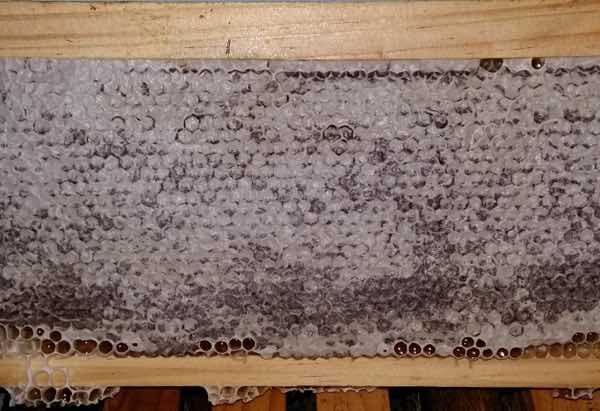
This page was last updated by Bernard Preston on 13th July, 2025.
How much honey in 1kg of comb?
The weight of honey in a kilogramme of comb depends on the depth of the cells and the density of the liquid. As a rule of thumb, the wax makes up about 15% of the whole.
So 1kg of deep, fully capped comb contains about 150 grams of wax and 850g of natural honey.
Why is honeycomb so expensive?
Natural honeycomb is expensive but if you look upon it as medicine, then it is very reasonably priced; cheap in fact and has none of the side effects of statins and anti-inflammatory drugs.
Most important it is the only known medicament for non-alcoholic fatty liver disease; no drugs are available to treat the condition.
Why is the comb so expensive? Firstly, it takes seven pounds of honey for bees to make just one of wax, so you have to pay for that.
Secondly and perhaps more important, a beekeeper will harvest honey three or four times in a season. If he sells comb then he will most likely only manage one or two crops. So you end up paying a lot for the lost opportunity that he would have had.
That is the reason that I do not sell honey in the comb; the price would be exorbitant, unless you recognise its value as your "meds" for some very serious conditions.
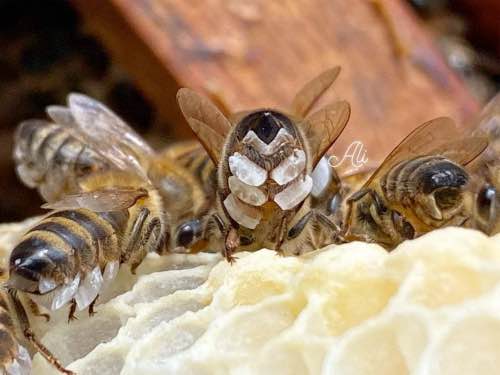
Many thanks Ali for this beautiful photograph of bees producing wax scales.
Natural honeycomb
The very best natural honeycomb is that which has no foundation; that which they produce from scratch. But only beekeepers get to enjoy this quality; one more reason to keep a hive in the garden.
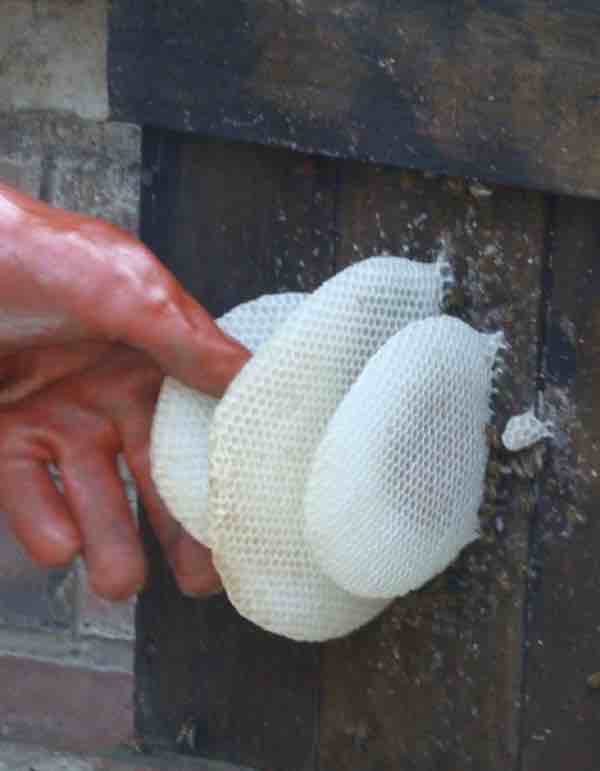
Honeycomb protects the liver
Natural honeycomb has profound health benefits protecting the liver.
Non-alcoholic fatty liver disease (NAFLD) is a very serious problem in many first world countries where up to 83% of people may be suffering from it; like diabetes it is a silent condition, suddenly striking and killing its victims.
In Korea for example it is the most common serious sickness affecting over half the population since the arrival of relative affluence; processed food high in refined carbohydrate and a sedentary existence lead to excessive fat deposition in the liver causing fibrosis and cirrhosis.
The obese and diabetics are the prime victims of this life-threatening disease; women are more often affected.
Research published in the Korean Journal of Internal Medicine, where NAFLD is rife, reports that no fully successful pharmacological intervention is available; but that alternative treatments using anti-inflammatory omega 3 fatty acids and beeswax have been shown to exhibit hepatoprotective effects[1].
100 mg of wax per day for six months was consumed. Despite no overall weight loss, generally the cornerstone of treatment of NAFLD, very significant changes were found in the liver of the treatment group, compared to placebos; insulin resistance, liver enzymes and ultrasound scans all showed improvement.
Researchers speculated that it was due to the antioxidant effect of the beeswax removing free radicals.
The material expressed on this page is gleaned from the nutritional and environmental literature; it is clearly referenced. A plain distinction is made between the author's opinion and that which is scientifically proven. When in doubt consult your health professional.
To suggest a correction or clarification, write to Dr Bernard Preston here. Contact.
Wax is made up of long-chain fatty acids
Further research published in Digestive Diseases and Sciences found in a pilot study that six months on ketogenic food showed a significant weight loss of 13kg on average, histological improvement and lessened inflammation[2].
Beeswax is a mixture of very healthy "long-chain" fatty acids and alcohols. Honey in a jar is of course technically a processed food, despite being completely unheated; so comb with the nectar is really the only truly natural form.
Long-chain fatty acids are the natural oils found in the olive, avocado and coconut, for example; and in fish, nuts and meat. Another example is linoleic, an essential compound that the body must ingest as it cannot synthesise it; others are ALA and EPA which are both omega 3[4].
Honeycomb protects your joints
The Indian Journal of Pharmaceutical Sciences reports that natural beeswax acts as a COX-inhibitor, one of the chief agents causing inflammation of the joints.
They report that it could help in managing inflammatory conditions that impair joint health, without the dangers of conventional medicines that effect the stomach and heart.(3)
Enhances your lipid profile
Natural honeycomb enhances the balance of fatty acids in the bloodstream, reducing the bad LDLs and increasing the good cholesterol. If you look upon it as a medication to take instead of statins, with their nasty side effects, then it is cheap at the price.
Natural honeycomb contains plenty of the phenolic compounds that reduce lipid accumulation in the liver and the serum[6]. Some of this benefit is from the bee pollen.
Benefits diabetics
Insulin resistance from the large amounts of refined starches in our food is the number one disease of this century; raised blood glucose has profoundly negative effects on every organ of the body.
But the wax in your natural honeycomb significantly reduces insulin levels, equivalent to taking metformin; it has profound benefits for diabetics.
Dr Robert Cywes, an abdominal surgeon who has done over 1000 liver biopsies confidently says that non-alcoholic fatty liver disease can be reversed in just one week by following this programme.
- Low carbohydrate, high fat meals.
- Intermittent fasting; a long period between meals and especially from dinner to breakfast. That is the exact opposite of constantly reaching for snacks because we feel famished; or perhaps just bored.
- Frequent physical activity.
Thus he would say that any honey with your comb must be strictly limited to less than three teaspoons of total sugars each day.
Dr Cywes when treating seriously ill people with fatty liver disease would say the comb by all means, but no honey at all for a period. I would agree.
The point has been made that the GI of carbs is determined by measuring the effect on blood glucose of normal people. Those who are insulin-resistant, obese and diabetic almost certain react quite differently.
Take a walk after every carb meal
Natural honeycomb is high in sugars that will raise the blood glucose abnormally if you are insulin-resistant. Always take a walk or get generally physically active after any starchy meal; and especially in the evening.
The average Western person today is eating over 100 pounds of sugar per year, plus many other refined starches. Honey should be included in these calculations.
The twenty year diabetes rule states that after enjoying 20 odd teaspoons per day (two colas) you will be very prone to the disease.
Personally I limit myself to about three teaspoons of honey and virtually no sugar each day.
Personal opinion of a beekeeper
As a beekeeper, I would personally recommend relatively small amounts of natural honeycomb with the raw honey on a daily basis but only if taken in the context of a high fibre meal and followed by physical activity; then it will not cause a surge in blood glucose.
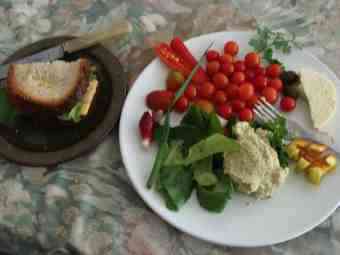 Honey on bread made from 100% flour, hummus and salad.
Honey on bread made from 100% flour, hummus and salad.The cancer society recommends a whole grain and a legume at every single meal.
Raw honey interestingly does not have the expected high glycemic index; all processed food should be treated with suspicion. Small amounts of pollen consisting of protein and fat lowers the GI.
Nevertheless these are simple sugars and indulging in more than a teaspoon or two of comb and honey per day is not recommended. A short ten-minute walk after the meal would be helpful in suppressing any rise in blood glucose.
In theory it would be possible to take a greater amount of natural comb after the nectar has been extracted leaving just the wax; that too would then be a processed food, something we are trying to avoid.
The treatment group in the fatty liver disease research mentioned above received 100 mg of wax per day; that is very little. Prevention with daily smaller amounts of natural honeycomb would probably be far superior.
Chew and swallow the natural honeycomb thoroughly.
As an aside chewing our food thoroughly is surprisingly a powerful inhibitor of Alzheimer's Disease. It is yet one more reason to enjoy whole, natural meals from which the fibre has not been extracted.
Newsletter
Our newsletter is entitled "create a cyan zone" at your home, preserving both yourself and Mother Earth for future generations; and the family too, of course. We promise not to spam you with daily emails promoting various products. You may get an occasional nudge to buy one of my books.
Here are the back issues.
- Lifestyle and ideal body weight
- What are ultra-processed foods?
- Investing in long-term health
- Diseases from plastic exposure
- Intensive lifestyle management for obesity has limited value
- A world largely devoid of Parkinson's Disease
- The impact of friendly bacteria in the tum on the prevention of cancer
- There's a hole in the bucket
- Everyone is talking about weight loss drugs
- Pull the sweet tooth
- If you suffer from heartburn plant a susu
- Refined maize meal and stunting
- Should agriculture and industry get priority for water and electricity?
- Nature is calling
- Mill your own flour
- Bake your own sourdough bread
- Microplastics from our water
- Alternative types of water storage
- Wear your clothes out
- Comfort foods
- Create a bee-friendly environment
- Go to bed slightly hungry
- Keep bees
- Blue zone folk are religious
- Reduce plastic waste
- Family is important
- What can go in compost?
- Grow broad beans for longevity
- Harvest and store sunshine
- Blue zone exercise
- Harvest and store your rainwater
- Create a cyan zone at your home
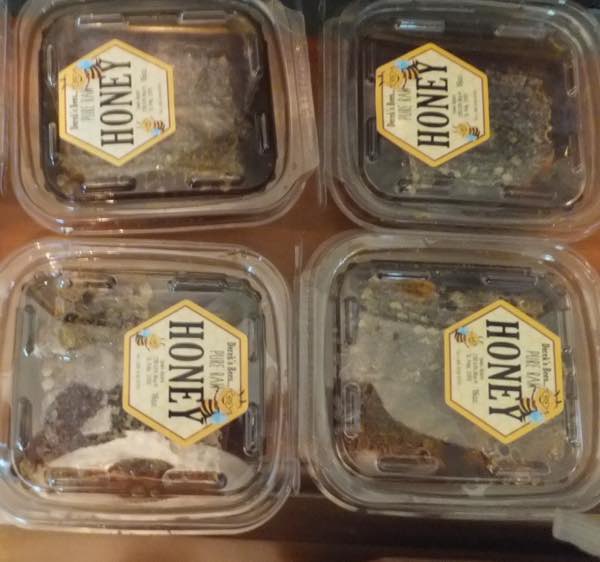
Expect to pay a lot; it really is worth much more than honey in a bottle.
Most 'keepers will refuse to sell honey in the comb; the exception is when by mistake they forget to put a frame back in the hive. The bees build their own totally natural comb which does not even even have a central sheet of foundation which can be a bit chewy.
It is worth every dollar; not cent. Expect to pay more.
Propolis
Propolis is a sort of sealant that bees use to block up cracks and crannies in their hives that are letting in too much air or water. It's fairly pliable and soft initially but gradually hardens to form a dark strong substance.
They also use it to glue your natural honeycomb in place.
It is found in every hive and they use it for example to bond the lid of the hive to the top chamber; when levering it off this seal first has to be broken.
Propolis is made of various resins that they garner from trees and plants; beeswax, essential oils and a number of important phytochemicals like kaempferol and quercetin that have proven anti-inflammatory properties in the body.
A tincture of propolis has been used since time immemorial for various ailments like scratches and wounds. It apparently also has benefits for many conditions like diabetes, helping to normalise blood glucose; and even the neurodegenerative diseases.
That I cannot vouch for, not having read the research; it is so easy to make a tincture. Usually it is done with alcohol but simpler is to chop or grind it up and add it to a bottle of olive oil; leave for a few weeks, shaking periodically, strain and simply use it on your salad every day. It has a various interesting flavours.
I will try using propolis in the future to make a mead; those nutrients will dissolve in the alcohol.
Bees love propolis. If you leave old hive parts out, the bees can be seen reclaiming it for reuse in their boxes.
It acts a powerful attractant when looking to trap new swarms; I add a few chunks to raw beeswax, heat it up in an old pot and drip it all over the catch-box. It is a normal part of natural honeycomb.
Read more about propolis[5].
When browsing use right click and "Open Link in New Tab" or you may get a bad gateway signal.
Did you find this page interesting? How about forwarding it to a friendly book or food junkie? Better still, a social media tick would help.
- Homepage
- Beekeeping
- Natural Honeycomb
Address:
56 Groenekloof Rd,
Hilton, KZN
South Africa
Website:
https://www.bernard-preston.com